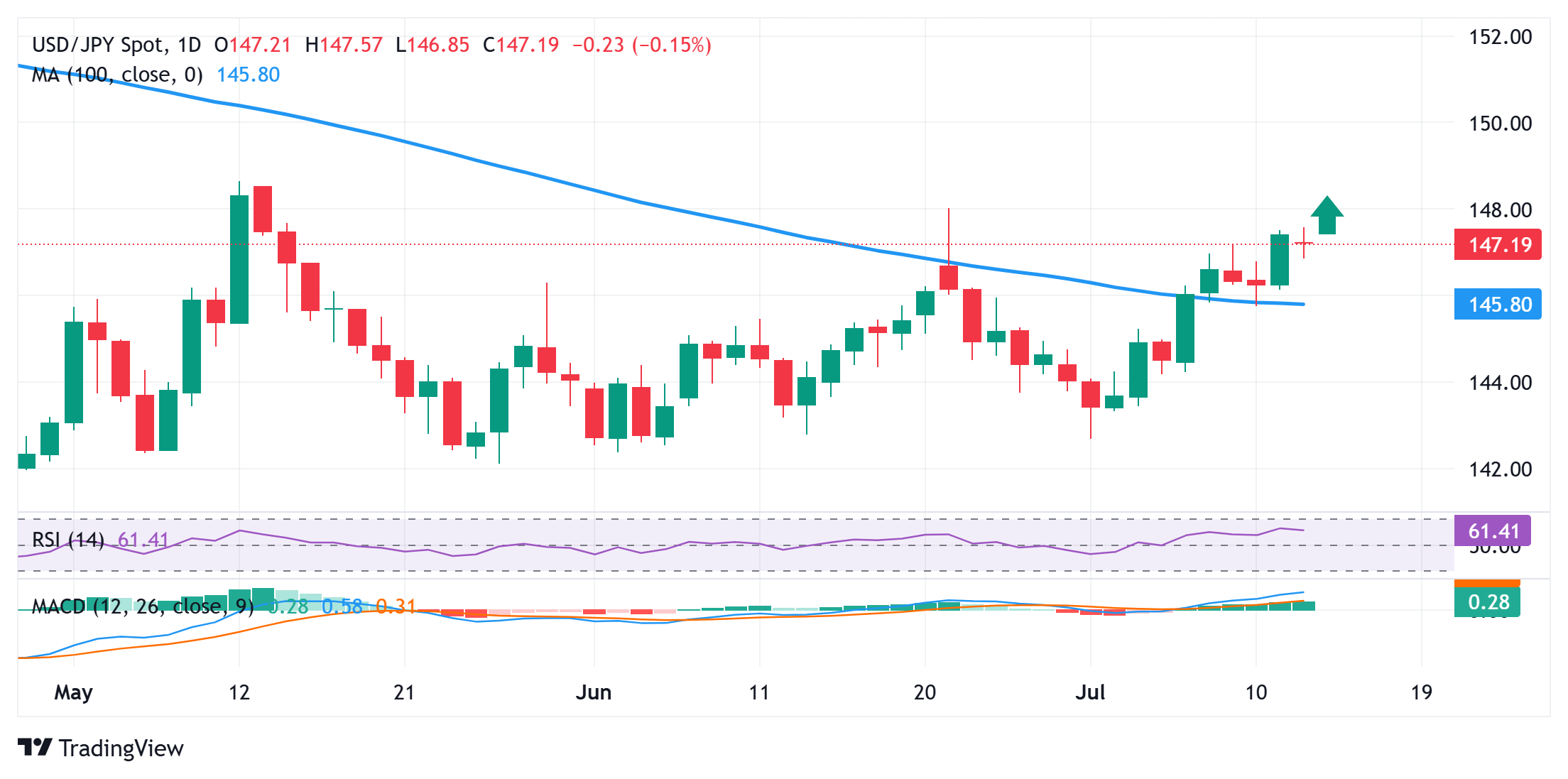- The Japanese Yen struggles to gain any meaningful traction amid trade jitters and reduced BoJ rate hike bets.
- Furthermore, domestic political uncertainty turns out to be another factor that acts as a headwind for the JPY.
- Diminishing odds for an immediate rate cut by the Fed lend some support to the USD and the USD/JPY pair.
The Japanese Yen (JPY) extends its sideways consolidative price move near a three-week low touched against a broadly firmer US Dollar (USD) earlier this Monday amid mixed cues. The global risk sentiment remains fragile in the wake of US President Donald Trump’s fresh threat to impose a 30% tariff on imports from Mexico and the European Union (EU) starting on August 1. This, in turn, benefits the safe-haven JPY, though diminishing odds for a Bank of Japan (BoJ) rate hike act as a headwind.
Against the backdrop of worries about the potential economic fallout from higher US tariffs, declining real wages, and signs of cooling inflation in Japan suggest that the BoJ will forgo raising interest rates this year. This is holding back the JPY bulls from placing aggressive bets. Apart from this, reduced bets for an immediate interest rate cut by the Federal Reserve (Fed) lift the USD to a fresh high in over two weeks, which turns out to be another factor acting as a tailwind for the USD/JPY pair.
Japanese Yen lacks firm intraday direction amid mixed cues
- In a further escalation of trade wars, US President Donald Trump announced new tariffs on two of the biggest trade partners – Mexico and the European Union – in separate letters on Saturday. This, in turn, tempers investors’ appetite for riskier assets and benefits the safe-haven Japanese Yen at the start of a new week.
- Earlier last week, Trump issued tariff notices to more than 20 countries, including Japan, and also a 50% tariff on copper imports. This comes on top of declining real wages and signs of cooling inflation in Japan, which, along with domestic political uncertainty, could allow the Bank of Japan to forgo raising rates this year.
- Recent media polls raised doubts about whether Japan’s ruling coalition of the Liberal Democratic Party (LDP) and Komeito will be able to secure enough seats to maintain their majority at the upper house election on July 20. This adds a layer of uncertainty and should keep a lid on any meaningful JPY appreciation.
- Traders pared their bets for a rate cut by the Federal Reserve later this month in anticipation of worsening inflation as a result of higher import taxes and a still resilient US labor market. This keeps the US Dollar close to a nearly three-week top touched earlier this Monday and offers support to the USD/JPY pair.
- Traders now look forward to the release of US inflation figures – the Consumer Price Index (CPI) and the Producer Price Index (PPI) on Tuesday and Wednesday, respectively. The data should provide cues about the Fed’s rate-cut path, which, along with speeches from influential FOMC members, will drive the USD.
- Meanwhile, the aforementioned fundamental backdrop warrants some caution for the JPY bulls and backs the case for the emergence of some dip-buying around the USD/JPY pair.
USD/JPY seems poised to climb further while above 100-day SMA

Last week’s sustained breakout through and a daily close above the 100-day Simple Moving Average (SMA) for the first time since February 2025 was seen as a key trigger for the USD/JPY bulls. Moreover, oscillators on the daily chart have been gaining positive traction and are still away from being in the overbought zone. This, in turn, suggests that the path of least resistance for the currency pair is to the upside. Some follow-through buying above the 147.50-147.55 region will reaffirm the constructive setup and lift spot prices to the 148.00 mark or the June swing high. The subsequent move up could extend further towards the May swing high, around the 148.65 region, en route to the 149.00 mark.
On the flip side, any corrective pullback could be seen as a buying opportunity near the 146.60-146.55 region. This is closely followed by the 146.25 intermediate support and the 146.00 round figure. Some follow-through selling, leading to a subsequent fall below the 100-day SMA, currently pegged near the 145.80 region, might shift the bias in favor of the USD/JPY bears and pave the way for a decline towards the 145.50-145.45 area en route to the 145.00 psychological mark.
Fed FAQs
Monetary policy in the US is shaped by the Federal Reserve (Fed). The Fed has two mandates: to achieve price stability and foster full employment. Its primary tool to achieve these goals is by adjusting interest rates.
When prices are rising too quickly and inflation is above the Fed’s 2% target, it raises interest rates, increasing borrowing costs throughout the economy. This results in a stronger US Dollar (USD) as it makes the US a more attractive place for international investors to park their money.
When inflation falls below 2% or the Unemployment Rate is too high, the Fed may lower interest rates to encourage borrowing, which weighs on the Greenback.
The Federal Reserve (Fed) holds eight policy meetings a year, where the Federal Open Market Committee (FOMC) assesses economic conditions and makes monetary policy decisions.
The FOMC is attended by twelve Fed officials – the seven members of the Board of Governors, the president of the Federal Reserve Bank of New York, and four of the remaining eleven regional Reserve Bank presidents, who serve one-year terms on a rotating basis.
In extreme situations, the Federal Reserve may resort to a policy named Quantitative Easing (QE). QE is the process by which the Fed substantially increases the flow of credit in a stuck financial system.
It is a non-standard policy measure used during crises or when inflation is extremely low. It was the Fed’s weapon of choice during the Great Financial Crisis in 2008. It involves the Fed printing more Dollars and using them to buy high grade bonds from financial institutions. QE usually weakens the US Dollar.
Quantitative tightening (QT) is the reverse process of QE, whereby the Federal Reserve stops buying bonds from financial institutions and does not reinvest the principal from the bonds it holds maturing, to purchase new bonds. It is usually positive for the value of the US Dollar.

